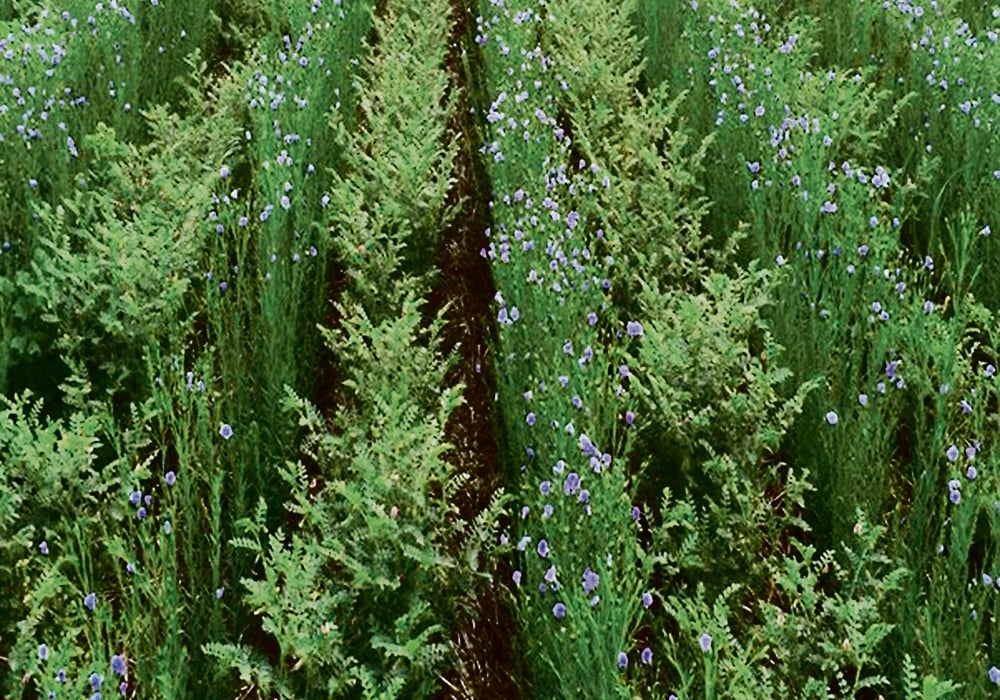Oilseed and pulse intercrops can result in better yields and nutrient use, according to research conducted at the University of Saskatchewan.
“Legumes are a good choice for intercropping due to their ability to biologically fix nitrogen, which can reduce competition for nitrogen in an intercrop system,” said Melanie Reid from the U of S.
During the College of Agriculture and Bioresources Soils and Crops virtual conference, Reid presented her masters project that investigated intercrops of CDC Orion Kabuli chickpea/CDC Glas brown flax, and CDC Inca yellow pea/Andante white mustard.
Read Also

Trump’s tariffs take their toll on U.S. producers
U.S. farmers say Trump’s tariffs have been devastating for growers in that country.
“The two pulse oilseed intercrop systems showed synergy and yield and nutrient efficiency, which may be attributed to the observed in-season transfer of soluble N from the legume to the oilseed partner,” Reid said.
The study examined the yield and nutrient uptake of the intercrops, including the phosphorus uptake in straw and seed.
The effects of pulse oilseed intercropping on nutrient cycling and availability were also examined by using alternative and mixed-row treatments.
Field trials were conducted in 2019 and 2020 at Redvers and Pilot Butte, Sask. There were periods of drought stress in both years of the study.
Seeding rates were based on previous studies by Lana Shaw, and the plots were hand weeded and hand harvested. No fertilizer was applied, but the pulse crops were inoculated.
“The efficiency of producing yield and grain, and in P uptake and removal per unit area of land are greater within the pulse/oilseed intercrop systems tested in the trial than their corresponding mono crops,” Reid said.
“This positive interaction indicated, in many cases, higher nutrient utilization efficiency values for intercropping.”
She said total dissolved nitrogen concentrations in the seed rows were higher in the pulse crops than in the oilseed crops in both intercropping systems, which may have contributed to the pulse/oilseed intercrop synergy.
“Biologically fixed nitrogen from the pulse crops was transferred to the oilseed intercrops.”
She said pulse oilseed intercrops should not be expected to improve soil nitrogen when used in low or no input cropping systems, especially under dry conditions.
“However, the benefit of in-season cross species N transfer could be a particular benefit under N deficiency and dry conditions, as was experienced and observed in the current study due to limited N mineralization and N mobility in the soil,” Reid said.
She added that the increased removal of phosphorus at harvest, associated with greater yield and nutrient demand, in these pulse/oilseed intercrops must be managed to maintain soil fertility.
“Presence of legume may enhance soil phosphorus scavenging. However, the similarity of root zone supply rates of phosphate, in intercrop and mono crop mustard in low available P soils, show that mustard is capable of solubilizing and removing soil phosphorus independent from a companion pulse crop,” Reid said.
Chickpea had better yield and nutrient uptake in alternate rows versus mixed rows, which indicates flax was dominant crop in that particular intercrop. Pea appeared to be the dominant crop in the pea/mustard intercrop.
“The shorter life cycle of pea may be an advantage to pea for drought avoidance. However, mustard has been shown in other studies to be poorly adapted to the drought conditions and high daytime temperatures experienced in this trial,” Reid said.
For pulse/oilseed intercrops, the seeding rate of the oilseed may need to be reduced under high available soil nitrogen conditions to help balance the resource needs of the crops.
Similarly, the pulse crop seeding rate may need to be increased under conditions with low available soil nitrogen.
“The higher yields of flax compared to mustard suggests that the chickpea flax intercrop system may be more suitable of the two systems investigated for drought conditions, as long as early establishment of chickpeas is ensured, and they are kept disease-free during the growing season,” Reid said.
For the nutrient cycling and availability component of the study, she said no large consistent differences between alternate and mixed row intercropping arrangements were observed.
















